Carps, like any other fish, are susceptible to various diseases. They are caused by various environmental factors. These include bacteria, viruses, toxic substances, helminths, fungi, algae, violations of hydrochemical and other external conditions.
Noncommunicable diseases
Conventionally, carp diseases can be divided into infectious and non-infectious. The latter are caused precisely by habitat disturbance. Such diseases include nutritional diseases that are caused by toxic feed, violations of the reservoir regime, and atypical temperature changes.
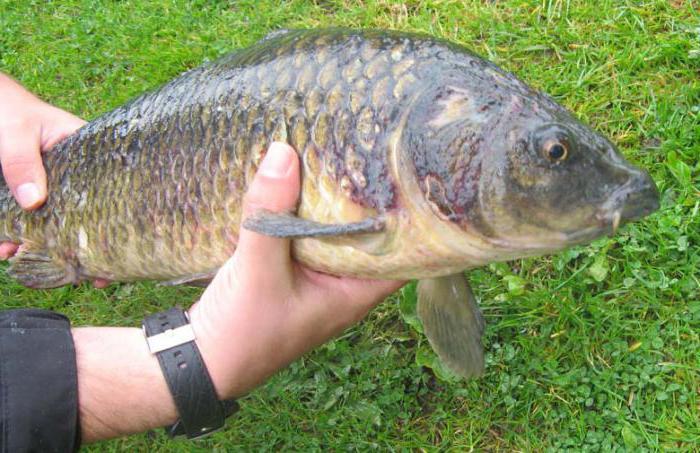
Many diseases arise due to impaired immunity of fish, as a result of various stresses. Non-communicable diseases are accompanied by the formation of pathogenic microflora.
Each disease has its own specifics and clinical picture. And at the same time, the manifestations of many diseases are very similar to each other. Any disorders in the metabolism of carps lead to impaired water-salt metabolism. As a result of this, the fish develop dropsy, blooming-eyed, and scales are ruffled. However, it is impossible to make a diagnosis only by appearance, since signs of diseases can also appear for other reasons. For example, from the bites of predators or when trapping.
Are fish diseases dangerous for humans?
Diseases of carp fish can be dangerous to humans. In addition to known helminthiases, fish can sometimes cause toxic infections in humans.
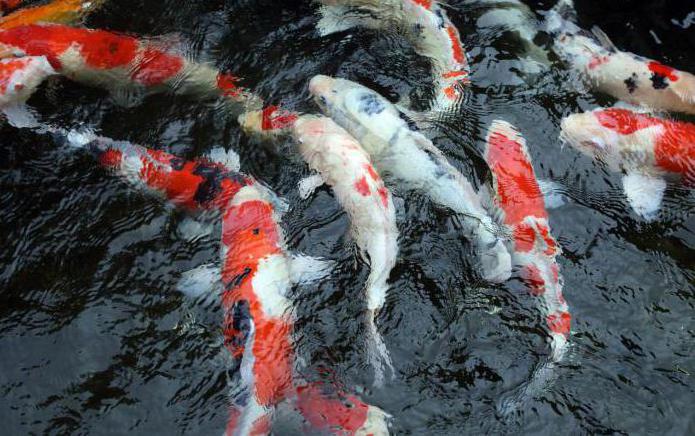
The main sources of the spread of the disease are uncontrolled transportation from not very prosperous farms to good ones. Other diseases are focal in nature. And this suggests that in some regions of the country wild fish are carriers of foci of infection, living in natural waters. Making your farm healthy in such an area is practically impossible, because transportation from such a region to a healthy body of water will lead to infection. Veterinary certificate Unfortunately, it does not always reflect reality. In general, cases of importation of diseased fish into healthy bodies of water have become more frequent, which may well lead to the collapse of the entire economy. This is very dangerous for those structures that organize fishing.
Since there are carp diseases that are dangerous for humans, you need to be careful about the choice of fish.
Infectious diseases
Let's talk about fish infectious diseases. One of them is gill necrosis. It is very dangerous and can lead to mass death of fish in a pond.
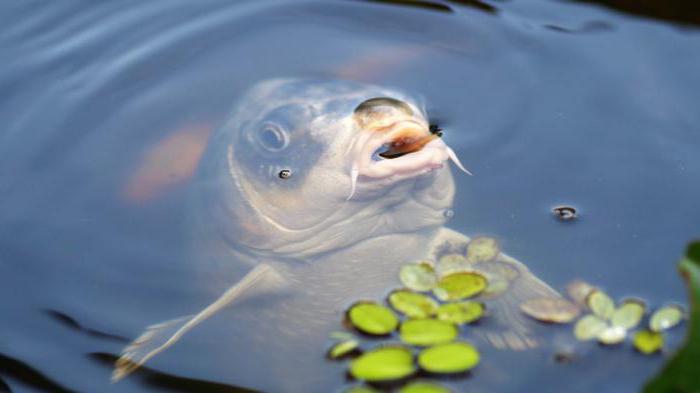
The disease can manifest itself in the middle and early summer, and in the fall it usually fades. Two-year-olds are susceptible to this carp disease. However, what is the cause is still unknown. Gill disease should be distinguished from branchiomycosis. The manifestations of these diseases are very similar. There are suggestions about the bacterial or viral nature of the phenomenon. However, it is noted that the disease is provoked by changes in the hydrochemical regime. Preventive measures are recommended in carp farms. Quarantines are imposed on the dysfunctional. The disease can cause significant damage.
Saprolegniosis
Saprolegniosis is the most common carp disease in the pond. It is believed that it is secondary in itself and is formed at the site of injuries on the body of the fish. In addition, it may appear on the basis of other diseases. The causative agents are protozoa, which are quite widespread.
This disease affects almost all freshwater fish. Very often it happens in carp farms due to careless handling. The fungus enters the gills, damaged tissues and destroys them.A gray coating is formed on the surface of the body, similar to contaminated cotton wool.

Saprolegniosis can only be prevented with preventive measures. All activities with fish should be carried out without injuries. You can use drugs such as salt, brilliant green for prevention and for medicinal purposes.
A variation of this disease is Staff’s disease, in which the nasal cavities of fish are affected. Mushroom mycelium covers the head, and can penetrate the brain. The disease usually occurs in winter during a period of severe cold.
Saprolegniosis also affects eggs in the hatchery, even salmon species suffer from the disease. At first, the disease affects dead eggs, and then goes on to healthy ones. To treat the disease, use diamond green, methylene blue, malachite green. You can prevent the disease by treating the water with an ultraviolet lamp, as well as by using ozonation.
Branchiomycosis
Many infectious diseases of carps are caused by fungi. Branchiomycosis also belongs to them. The causative agent destroys the gills. A sick fish does not take food, keeps near the shore, rises to the surface. As a rule, this disease appears in the summer and leads to mass death of fish. The infected pond is quarantined, dead fish is caught and destroyed. In autumn and spring, ponds are disinfected with quicklime.
Carp diseases and their treatment for rubella
Rubella is one of the most dangerous diseases of carp and carp. In addition, rubella can affect the line, crucian carp, grass carp. This is a very contagious disease, the source of which is still unknown. Some experts believe that it is caused by bacteria, while others - by viruses. In fact, the term “rubella" refers to a number of diseases that are similar in symptoms. All of them are caused by different bacteria and viruses.
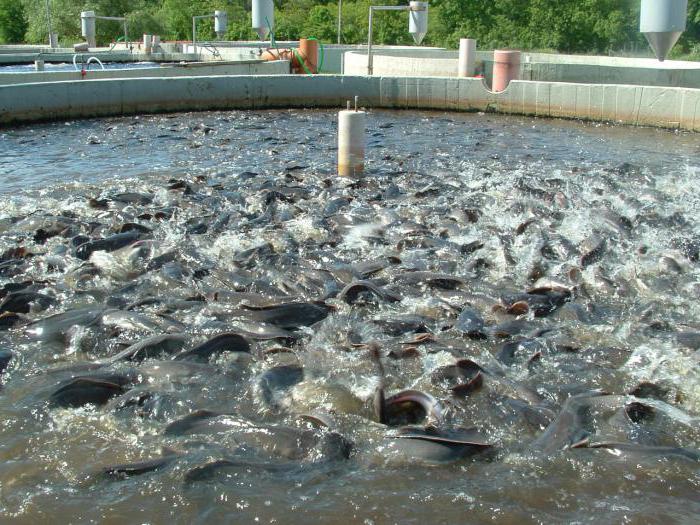
Rubella usually occurs in the spring or early summer. Sometimes there are surges in the winter. The disease affects two-year and three-year-old individuals. In case of an unfavorable course of the disease, eyebrows, ruffled scales, dropsy are noted. Ulcers may form. Chronic rubella is characteristic of the second half of summer with the formation of ulcers on the fins. However, the right diagnosis can only be made by a knowledgeable specialist in a comprehensive study.
Such diseases of carps are treated with the following drugs: tetracycline, chloramphenicol, biomycin. The use of probiotics is now in practice. Treatment is prescribed by a special doctor, taking into account the characteristics of each reservoir. Improper use of antibiotics can only do harm.
To improve the economy, there is one wonderful method that gives reliable results. Ponds are drained and processed by special means, and fish is disposed of or sold.
Bladder inflammation
Discussing carp diseases (photos are given in the article), it is necessary to mention inflammation of the swimming bladder. The exact cause of the phenomenon has not been elucidated. The main point of view is the viral etiology. The infection is transmitted through direct contact of fish, but the transmission route through soil and water is not excluded.
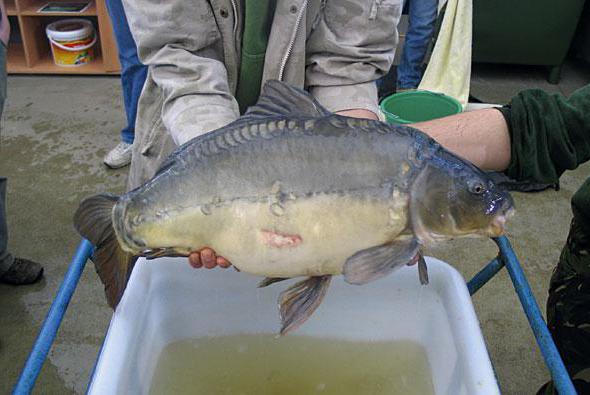
Carps and carp are susceptible to the disease. The disease affects the walls of the swim bladder, capturing other organs. Even the mass death of fish is possible. Over time, the fish become immune to this disease, and it fades. But this option is possible only subject to quarantine.
Carp koi
Koi bred in Japan by breeding. Such fish poorly resist various diseases. Often koi live in completely inappropriate places, such as lakes for carp. Such ponds, as a rule, have a depth of up to sixty centimeters. For Koi this is not enough, they need a depth of at least 120 centimeters. In addition, it is important for them what quality the water is around.If the reservoir is overpopulated, then there are more pathogenic bacteria there, which means that they will find their target faster.
All negative factors cause fish stress, which lowers immunity. And then the fish get sick faster. Koi carp diseases are the same as those of other members of the family.
Fish parasitic diseases
Fish living in natural water bodies are usually saturated with various parasitic organisms. With a small number of them, the fish do not suffer from their presence at all. However, with industrial fish farming, the number of individuals in the pond is much larger than in the natural environment. And this leads to a sharp increase in diseases.
Parasitic diseases of carp and their treatment
Most often, when breeding carp, there is such a disease as ichthyophthyroidism. In addition, trichodiniasis, apiosomiasis, caviosis, boneosis, phylometroidosis are common.
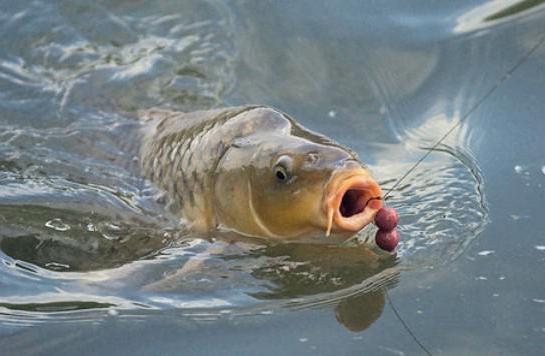
For their effective treatment, you need a correctly diagnosed, then, in principle, you can cope with the disease.
Ichthyophthyroidism is a dangerous disease that can cause massive pestilence of fish. The reason is a small parasite resistant to many antibiotics. It develops under the skin of fish, which become lethargic, and a whitish rash is visible on their body. Treatment is carried out only under the guidance of a specialist. A preventive measure is the exclusion of foreign fish from entering water bodies.
Carp phylometroidosis
Carp phylometroidosis is caused by nematode worms. They live in the pockets of carp scales. When cleaning infected fish, a person discovers pink rings. These are female filometers. In fact, this parasite is not dangerous for humans, but still it is better not to eat such fish, even from the point of view of aesthetics. The cause of this disease is the transport of fish from a clean farm to an infected one.
Instead of an afterword
As we can see, carps are susceptible to many different diseases, among which there are dangerous to humans and non-dangerous. Be that as it may, but when acquiring fish, especially in the markets, be careful about its appearance. Although external well-being does not always reflect the real state. If you have any suspicions when cooking at home or you find parasites, it is better not to eat such fish, since you yourself will not determine the degree of its danger, for this you need a specialist and clinical examinations.








